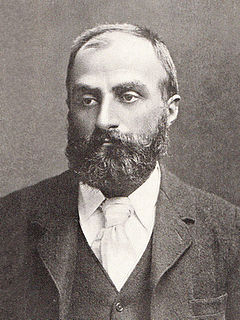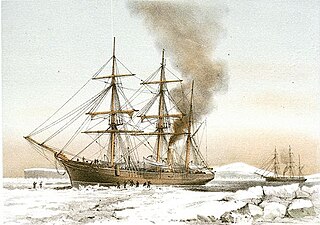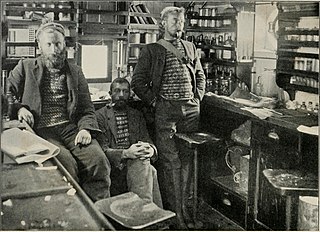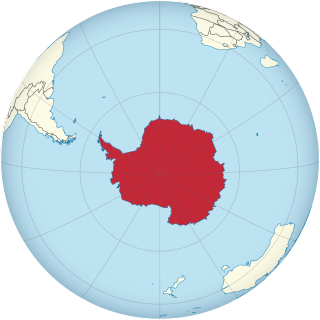
Erich Dagobert von Drygalski was a German geographer, geophysicist and polar scientist, born in Königsberg, East Prussia.

Sir Clements Robert Markham was an English geographer, explorer, and writer. He was secretary of the Royal Geographical Society (RGS) between 1863 and 1888, and later served as the Society's president for a further 12 years. In the latter capacity he was mainly responsible for organising the British National Antarctic Expedition of 1901–1904, and for launching the polar career of Robert Falcon Scott.

William Speirs Bruce was a British naturalist, polar scientist and oceanographer who organized and led the Scottish National Antarctic Expedition to the South Orkney Islands and the Weddell Sea. Among other achievements, the expedition established the first permanent weather station in Antarctica. Bruce later founded the Scottish Oceanographical Laboratory in Edinburgh, but his plans for a transcontinental Antarctic march via the South Pole were abandoned because of lack of public and financial support.

Multiple governments have set up permanent research stations in Antarctica and these bases are widely distributed. Unlike the drifting ice stations set up in the Arctic, the Research stations of the Antarctic are constructed either on rock or on ice that is fixed in place.

The Scottish National Antarctic Expedition (SNAE), 1902–1904, was organised and led by William Speirs Bruce, a natural scientist and former medical student from the University of Edinburgh. Although overshadowed in terms of prestige by Robert Falcon Scott's concurrent Discovery Expedition, the SNAE completed a full programme of exploration and scientific work. Its achievements included the establishment of a staffed meteorological station, the first in Antarctic territory, and the discovery of new land to the east of the Weddell Sea. Its large collection of biological and geological specimens, together with those from Bruce's earlier travels, led to the establishment of the Scottish Oceanographical Laboratory in 1906.

The Dundee Whaling Expedition (1892–1893) was a commercial voyage from Scotland to Antarctica.
William (Bill) Barr is a Scottish historian now resident of Calgary, Canada, with a specific interest in the history of exploration of the Arctic, and to a lesser degree, the Antarctic. He holds degrees in Geography from the University of Aberdeen, Scotland and McGill University, Montreal, Canada. From 1968 until 1999 he was a member of the faculty of the Department of Geography, University of Saskatchewan, Saskatoon, Canada and is now a professor emeritus there.
The Heroic Age of Antarctic Exploration was an era in the exploration of the continent of Antarctica which began at the end of the 19th century, and ended after the First World War; the Shackleton–Rowett Expedition of 1921–1922 is often cited by historians as the dividing line between the "Heroic" and "Mechanical" ages.

John Riddoch Rymill was an Australian polar explorer, who had the rare second clasp added to his Polar Medal.
Hugh Robert Mill was a Scottish geographer and meteorologist who was influential in the reform of geography teaching, and in the development of meteorology as a science. He was President of the Royal Meteorological Society for 1907/8, and President of the Geographical Association in 1932.

HMS Discovery was a wood-hulled screw expedition ship, and later storeship, formerly the sealing ship Bloodhound built in 1873 in Dundee. She was purchased in 1874 for the British Arctic Expedition of 1875–1876 and later served as a store ship. Discovery was sold in 1902, reverting to the name Bloodhound and her previous sealing trade. The ship was wrecked in Newfoundland in 1917.
Rudmose Brown Peak is a peak 7 nautical miles (13 km) south of the coast and 8 nautical miles (15 km) southwest of Mount Hurley. It was discovered in January 1930 by the British Australian New Zealand Antarctic Research Expedition (BANZARE) of 1929-31 under Mawson, who named this feature for Dr. Robert Neal Rudmose-Brown, a naturalist of the Scottish National Antarctic Expedition of 1902–04, a member of the Scott Polar Research Committee of 1939–41, and author of numerous books and articles on Antarctica.

Rudmose Rocks is a group of rocks 0.4 nautical miles north-northwest of Cape Geddes, off the north coast of Laurie Island in the South Orkney Islands. The rocks were charted in 1903 by the Scottish National Antarctic Expedition under William Speirs Bruce, who named them for Robert Neal Rudmose-Brown, naturalist of the expedition.
Browns Bay is a bay 1.5 miles wide, entered between Thomson Point and Cape Geddes along the north coast of Laurie Island, in the South Orkney Islands. Charted in 1903 by the Scottish National Antarctic Expedition under Bruce, who named it for Robert Neal Rudmose-Brown, naturalist of the expedition.

Dr James Hunter Harvey Pirie FRSE FRCPE was a 20th-century Scottish medical doctor, philatelist, orchid-grower and bacteriologist. Pirie named the bacterial genus Listeria in honor of Joseph Lister and the Pirie Peninsula is named after him. Cape Mabel was named after his wife. In authorship he is known as J. H. H. Pirie.

This is an alphabetical index of all articles related to the continent of Antarctica.

William Gordon Burn Murdoch was a Scottish painter, travel writer and explorer. Murdoch travelled widely including India and both the Arctic and the Antarctic. He is said to be the first person to have played the bagpipes in the Antarctic. He published several travel books as well as being an accomplished artist. A cape in the South Orkneys is named in his honour.

The Ross expedition was a voyage of scientific exploration of the Antarctic in 1839 to 1843, led by James Clark Ross, with two unusually strong warships, HMS Erebus and HMS Terror. It explored what is now called the Ross Sea and discovered the Ross Ice Shelf. On the expedition, Ross discovered the Transantarctic Mountains and the volcanoes Erebus and Terror, named after his ships. The young botanist Joseph Dalton Hooker made his name on the expedition.
Ann Savours Shirley, historian of polar exploration, both Arctic and Antarctic, was born on 9 November 1927 in Stoke-on-Trent, England. She is most widely known for her study of Robert Falcon Scott's ship HMS Discovery.
David Edward Sugden FRSE, FRSGS is an emeritus professor and senior research fellow at the University of Edinburgh. He is a glaciologist and glacial geomorphologist. His research focuses in particular on glacial and polar landforms, Antarctic ice sheet stability, and the dynamics of the Patagonian ice cap under a changing climate. He has served as President of the Geography Section of the British Association, Vice President of the Royal Geographical Society, President of the Institute of British Geographers, and Director of SAGES. At the University of Edinburgh, Sugden has twice been Department Head of Geography and was also the inaugural Head of the School of Geosciences.













